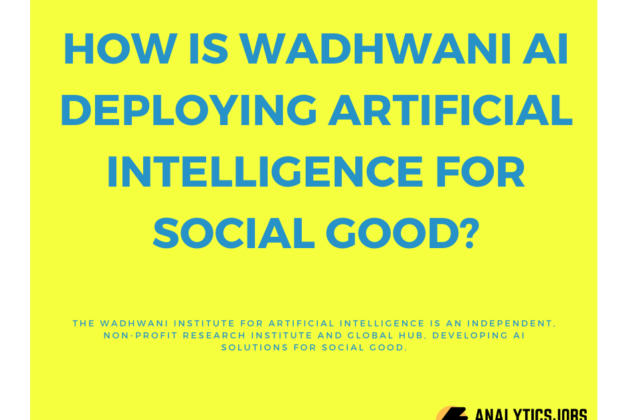Artificial Intelligence for social good?
This jargon looks and makes you feel good. Isn’t it?
But are we really up to this when Corporate Social Responsibility (CSR) is merely a show and lacks groundwork?
Well, there’s one named Wadhwani AI. As per its website home page, “The Wadhwani Institute for Artificial Intelligence is an independent, non-profit research institute and global hub, developing AI solutions for social good.”
The benefits of artificial intelligence have been limited only to handfuls. However, AI has got the potential to benefit the masses. Wadhwani AI is deploying its skills and talent for this more significant cause. The whole team at Wadhwani AI is working towards a common goal of developing AI-based solutions to bring a change across various domains like healthcare, infrastructure, education for all, agriculture, and financial inclusion. They are working with the government with the aim of uplifting masses from poverty and make a path breaking change in the lives of the underserved and nonprivileged masses of the country and the world as a whole.
At present, Wadhwani AI is working in three areas :
1. Cotton Farming:
Thousands of hectares of India’s leading cash crop cotton farming gets damaged due to the lack of integrated pest control management. More than 75% of cotton farming is done by the small landholder and marginalized farmers who every year struggles with uncertainty over their grown cotton crops. Wadhwani artificial intelligence is working towards minimizing crop losses due to pests vis employing AI to crop management.
They’re working on algorithms to identify the major pests affecting cotton farms. They are conducting field trials in many locations in deep partnership using the Better Cotton Initiative as well as the Government of Maharashtra.
Google.org announced this year that the Mumbai based Wadhwani Institute for Artificial Intelligence has been recognized as one of the twenty organizations it’d shortlisted using the Google AI Impact Challenge. Wadhwani Institute is going to receive a two dollars million grant offered by Google.org to produce technologies to minimize crop loss in cotton agriculture. The business is going to use Integrated Pest Management for that.
2. AI-Powered Anthropometry:
Anthropometry is basically a measurement of an individual.
Babies are generally weighed when they are born, or perhaps most likely within the very first couple of days following birth; therefore, this specific weight is a well-established hint of the all-around health of theirs. Newborns that weigh somewhere between 2.5 3.5 kilograms are typically considered as healthy. Nevertheless, every year, over 20 million newborns worldwide confront a lifetime of severe and lengthy ill health due to being born with lesser birth weight, that is, beneath 2.5 kgs.
Low-birth-weight babies are much more vulnerable to die during the very first month of theirs of existing and those that manage to survive face long term consequences, as a greater possibility of stunted advancement, decreased IQ, and adult-onset chronic ailments like obesity and diabetes. Almost one-half of these babies are created in South Asia. India has one of most likely the top incidences of low-birth-weight babies to the planet, and possibly the greatest percentage of infants not considered or perhaps possibly inaccurately considered at birth. Low-birth-weight babies account for forty-eight% of newborn deaths.
Decreasing the mortality rate of newborn babies has always been the Indian Government prerogative. But still, we have a very cruel newborn mortality rate.
Wadhwani institute of artificial intelligence is developing an AI-powered smartphone-based anthropometry application which is going to empower health workers to filter low-birth-weight babies with no specialized equipment or maybe physical examinations.
Wadhwani AI is actually the first and only recognized competitor from Asia and India, and one of the team from the growing community among the thirty four recognized competitors from across the globe, which are actually vying because of the IBM Watson AI XPRIZE, a worldwide competition challenging teams to create effective Artificial Intelligence (AI) based uses and demonstrate how humans are able to collaborate with AIs to deal with the world’s greatest obstacles.
3. Eradication of Tuberculosis:
A lot more people die of tuberculosis as compared to HIV as well as malaria put together. Despite a robust eradication program, nearly one-half of all tuberculosis cases within India go undetected.
In 2016, there have been 10.4 million brand new active tuberculosis instances as well as 1.7 million deaths anywhere. It’s believed that as a lot as fifty % of tuberculosis cases might go unknown and unreported.
Tuberculosis is the result of a bacterium known as Mycobacterium tuberculosis. The bacterias can strike any part of the entire body like the brain, spine, and the kidney, but typically attack the lungs, within which case it’s infectious. In fact, not addressed correctly, tuberculosis could be fatal.
As the recognized AI partner for India’s Central Tuberculosis Division, the things that work to Wadhwani AI edge is actually the point that the situations are actually favorable to their work – there already are available a centralized approach and execution; specific government staff as well as budgets; assistance from organizations like WHO; formidable digital infrastructure, and numerous touchpoints across a patient’s adventure.
Today, they’re producing technologies to deal with several challenges throughout the cascade of TB treatment, beginning with caseload estimation on the district amount making use of a bunch of risk and transmission elements to help find missing cases, as well as the prioritization of TB people for overall health employees through stratification of the threat of drop off from treatment.



